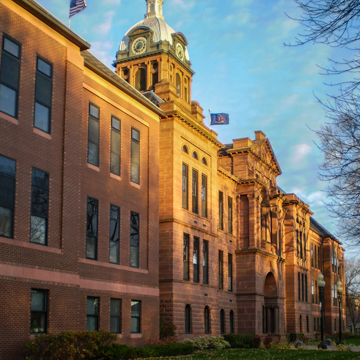Minneapolis architect Leroy S. Buffington won the commission in 1903 for the second courthouse on this site based on his proposal for a turreted, asymmetrical design that could be described as Queen Anne. Buffington loomed large in northern Dakota Territory despite competition from local architects. When the capital moved in 1883 from Yankton (now in South Dakota) to the territory’s center at Bismarck, Buffington easily won the lucrative commission for the new capitol building. But he badly miscalculated soil conditions in Fargo, where the foundations for the proposed courthouse were so poorly constructed that they began to crack and sink into the Red River Valley gumbo. There were hints that a vein of quicksand crossed the courthouse site and Buffington was held accountable for the consequences. Fired from the job, he was replaced by Fargo architects Daniels and Proctor. After making adjustments for the poor bearing capacity of the soil, other changes were made to Buffington’s design, which then served with minor modifications for twenty years.
A fire in 1903 caused sufficient damage to require a new courthouse. There was one major design requirement: the frugal county fathers felt that since such a substantial investment had been made in the 1883 building’s foundations, any new design had to be based on its existing footprint. Invitation for proposals from architects brought more than a dozen competitors, all of whom presumably met the footprint stipulation. Charles Emlen Bell submitted and won the commission with the only design that did not. Bell had several courthouses and the new Montana capitol of 1902 to his credit. For Cass County, Bell created a symmetrical Renaissance Revival design of red Lake Superior sandstone that he had used in Montana—Missoula and Anaconda—each with testimonials and a verifiable cost. Thus the only proposal that did not meet the one principal criterion was chosen, causing much consternation to the other competitors. And Bell had sown the seeds that would haunt him sixteen years later. In 1920 he applied for a North Dakota license but was denied the privilege when critical letters were submitted by George and Walter Hancock, whom he had trumped in the 1904 competition. Bell never again sought work in North Dakota.
In the 1950s a passenger elevator was inelegantly inserted into the ceremonial rotunda, but was later removed and the muraled rotunda with its upper balcony was restored. A pair of well-detailed additions respectfully balanced the front elevation.


